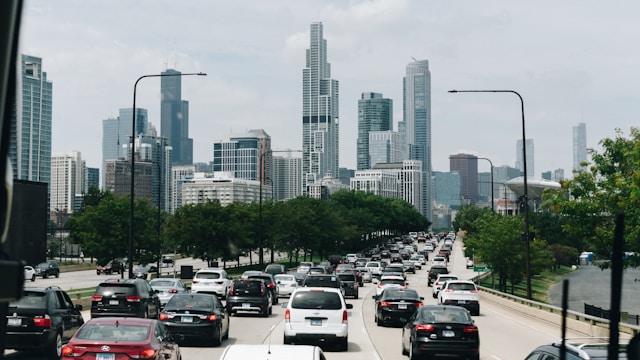Chicago is known for many things—deep-dish pizza, iconic architecture, and, unfortunately, traffic. With more than 1.5 million registered vehicles and a bustling population relying on rideshare services, the city's streets are more crowded than ever. Now add in construction zones, aggressive drivers, and the pressure of on-demand ride apps, and you've got a recipe for rising collision rates, especially involving Uber vehicles.
While Uber offers convenience, it also introduces new complexities into the world of traffic safety. Uber drivers are often navigating unfamiliar streets, juggling app notifications, and racing against time to maximize fares. In this high-pressure, tech-driven environment, crashes are becoming more frequent and more complicated when it comes to determining who's at fault.
The Uber Surge: How Rideshare Popularity Compounds Congestion
Uber has transformed urban transportation, but it hasn't done so without consequence. In neighborhoods like River North, the Loop, and Wicker Park, Uber vehicles often flood already-busy streets, especially during rush hours and weekend nights. This saturation contributes to more frequent stop-and-go traffic, illegal pickups, and double-parking—all of which increase accident risks.
These congestion-related behaviors don't just frustrate other drivers—they create dangerous traffic patterns where pedestrian and cyclist safety is also compromised. The more Uber vehicles flood the streets, the greater the chance that visibility is reduced and sudden movements cause chain-reaction crashes.
App Distraction: A Digital Hazard Behind the Wheel
Unlike traditional drivers, Uber operators rely heavily on a phone-based platform for everything—navigation, accepting rides, chatting with passengers, and tracking income. This constant app interaction, even when mounted, creates cognitive and visual distractions that make them more susceptible to missing traffic cues, braking late, or swerving unexpectedly.
Even when hands-free, these distractions are real. Split attention can reduce reaction time and increase risk. In legal terms, this can open the door to liability, even if the Uber driver wasn't intentionally negligent.
Who Pays When an Uber Crash Happens? Understanding the Insurance Puzzle
One of the most confusing parts of an Uber-related crash is figuring out who pays. Is it the driver's personal insurance? Uber's commercial policy? The passenger's policy? It depends heavily on what “phase” the Uber driver was in during the crash—whether they were waiting for a ride request, on the way to a passenger, or mid-ride.
This is where a skilled Uber accident lawyer becomes invaluable. Determining liability and accessing Uber's $1 million commercial insurance coverage requires proving exactly what the driver was doing at the moment of the crash. Without legal representation, accident victims—especially pedestrians or passengers—can find themselves shuffled between policies and denied full compensation.
Gig Pressure: How the Uber Business Model Encourages Risky Driving
Uber drivers are paid per ride, not per hour, which incentivizes fast turnover and constant availability. This can lead to dangerous behaviors like speeding between pickups, running yellow lights, or forgoing breaks to complete more rides during surge pricing. Fatigue becomes another hidden danger, as some drivers log double-digit hours to make ends meet.
The gig economy model, while flexible, puts profit above public safety. When Uber drivers are rushing to complete rides, distracted by app metrics, or struggling with fatigue, the risk of poor decision-making behind the wheel increases significantly. Moreover, this relentless pressure to maximize earnings often compromises their ability to prioritize passenger safety, leading to potentially dangerous situations on the road.
Passengers Are Vulnerable—and Often Left in the Dark
Uber passengers rarely have control over route, speed, or driving behavior, but they often pay the price when something goes wrong. Many are unaware of what steps to take after a crash or who to contact. In serious collisions, riders may assume Uber will handle everything, but that's rarely the case.
If you're hurt while riding in an Uber, it's critical to collect driver information, file a report within the app, and seek immediate medical care. Without taking these steps, you could miss your chance to make a claim or be pressured into accepting a lowball settlement. Additionally, document any visible injuries and gather witness statements to strengthen your case.
When Third Parties Are Involved: Multi-Vehicle Uber Crashes
Not all Uber accidents are straightforward. In busy intersections or downtown traffic, crashes often involve multiple vehicles, pedestrians, or cyclists. In these cases, determining fault becomes even more complex, especially when dashcams, ride logs, and GPS data must be analyzed to understand the sequence of events.
A strong legal team can subpoena Uber records, interview witnesses, and work with accident reconstruction experts to build a clear picture of what happened—and who should pay. Without this level of investigation, victims are often blamed unfairly or offered inadequate compensation.
Pedestrians and Cyclists: The Overlooked Victims of Uber Collisions
Rideshare congestion doesn't just affect passengers and other drivers. Pedestrians and cyclists are increasingly involved in Uber-related accidents, especially in areas where Ubers pull over without warning to pick up or drop off riders. In many cases, these incidents go unreported, or victims don't realize they can hold Uber accountable.
Victims who aren't in a vehicle still have rights. If injured by an Uber driver—even as a pedestrian—you may be entitled to coverage under Uber's insurance, depending on when the crash occurred and what role the driver was fulfilling at the time.
What to Do Immediately After an Uber Crash in Chicago
If you're involved in an Uber crash—whether as a passenger, pedestrian, cyclist, or another driver—the steps you take in the minutes and hours that follow are crucial. First, prioritize your safety and seek medical attention, even for minor symptoms. Then, document everything: take photos of the scene, vehicles, street conditions, and visible injuries. Be sure to collect the Uber driver's name, license plate, and insurance information.
Don't rely solely on the Uber app to protect your interests. File a police report, request medical records, and avoid speaking to insurance adjusters without legal representation. Uber's liability system is complex, and without a clear legal advocate, victims risk being undercompensated or dismissed entirely. Taking early, informed action can significantly strengthen your case.






